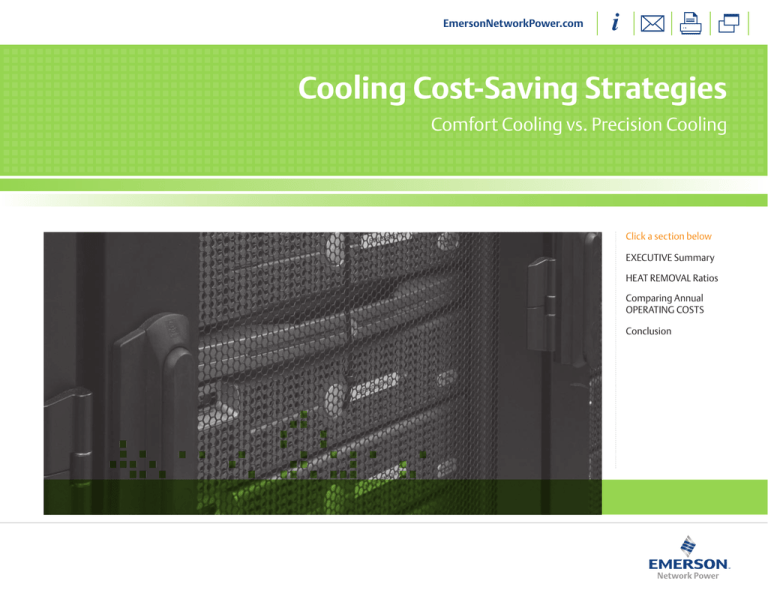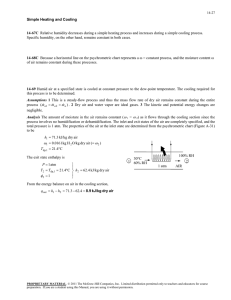
EmersonNetworkPower.com
Cooling Cost-Saving Strategies
Comfort Cooling vs. Precision Cooling
Click a section below
EXECUTIVE Summary
HEAT REMOVAL Ratios
Comparing Annual
OPERATING COSTS
Conclusion
EmersonNetworkPower.com
Executive Summary
Computer systems are critically sensitive to extreme variations in temperature and humidity. High heat
EXECUTIVE Summary
or humidity can cause failure, degrade performance and shorten equipment life. Important differences
HEAT REMOVAL Ratios
exist between precision cooling and building air conditioning (comfort cooling) in controlling these
environmental conditions. These differences dramatically impact the cost effectiveness of these systems. In
this paper, we compare both cooling systems’ ability to maintain favorable environmental conditions, and
their energy efficiency and annual operating costs.
Comparing Annual
OPERATING COSTS
Conclusion
> Click to watch
“Precision vs. Comfort Cooling
in Smaller IT Spaces”
Can’t get to YouTube at work?
Case Study: Sequent
Emerson Network Power | Cooling Cost-Saving Strategies
PG 1
EmersonNetworkPower.com
HEAT REMOVAL Ratios
Understanding heat removal ratios is important to understanding the efficiency of cooling systems. There are
EXECUTIVE Summary
two types of cooling: latent and sensible. Latent cooling is the ability of the air conditioning system to remove
HEAT REMOVAL Ratios
moisture, which is important in comfort cooling environments where people give off humidity. Sensible cooling
is the ability of the air conditioning system to remove heat that can be measured by a thermometer. The dryer
heat generated by electronic equipment is included in this category.
Comparing Annual
OPERATING COSTS
Conclusion
The American Society of Heating, Refrigerating and Air-Conditioning Engineers (ASHRAE) recommends
guidelines for data center heat and humidity. ASHRAE recommends data center temperatures fall between 18
and 27 degrees Celsius (64.4 to 80.6 degrees Fahrenheit) and that data center humidity levels be measured by
dew point and fall within 5.5 and 15 degrees Celsius (41.9 to 59 degrees Fahrenheit).
Comfort cooling systems have a sensible heat ratio (SHR) of 0.60 to 0.70. This means 60 to 70 percent of their energy
used is dedicated to lowering temperature, and 30 to 40 percent is dedicated to removing humidity. IT spaces
require a 0.80 to 0.90 sensible heat ratio for effective and efficient cooling. Precision cooling systems have been
designed with a sensible heat ratio of 0.85 to 1.0. This means 85 to 100 percent of their effort is devoted to cooling
and only 0 to 15 percent to removing humidity; therefore, it will take a larger comfort cooling unit to cool the same
IT environment as a precision system. In general, it takes three tons of comfort cooling capacity to equal two tons of
precision cooling capacity.
Emerson Network Power | Cooling Cost-Saving Strategies
PG 2
EmersonNetworkPower.com
Comparing Annual
OPERATING COSTS
Comparing heat removal costs between comfort and precision cooling systems reveals significant operational
EXECUTIVE Summary
savings for precision systems, even for relatively small data centers.
HEAT REMOVAL Ratios
For example, in a 500-square-foot data center operating at 72 degrees Fahrenheit and 50 percent relative
Comparing Annual
OPERATING COSTS
humidity, with equipment producing a heat load of 9 tons and an energy price of $0.10/kWh, a 15-ton comfort
cooling system consuming 18.5 kW of power to run the compressors and fan would cost $1,878 per sensible ton
Conclusion
per year to operate for heat removal alone. A 10-ton precision cooling system consuming 12.5 kW of power to run
the compressors and fan, by comparison, would typically cost $1,258 per sensible ton per year.
Bottom line: When the cost of re-humidification is factored in, the total annual operating cost of the comfort
cooling system is $11,986 higher than the operating cost of the precision cooling system. Such savings may offer a
typical payback within 12 months on the additional cost of a precision cooling system.*
* Re-humidification based on 2.34 kW of latent heat removal per ton of sensible cooling for the comfort cooling
system and 0.39 kW of latent heat removal per ton of sensible cooling for the precision cooling system, with the
humidifier running from November through March for a total of 3,650 hours.
> Click to watch
“Selecting a Cooling System”
Can’t get to YouTube at work?
Consider Total Cost of Ownership
Emerson Network Power | Cooling Cost-Saving Strategies
PG 3
EmersonNetworkPower.com
Conclusion
Because they are more effective at removing sensible heat and controlling humidity levels, precision cooling systems
EXECUTIVE Summary
require less power to operate than comfort cooling systems. When initial costs and operating costs both are taken into
HEAT REMOVAL Ratios
account, precision cooling systems represent the most cost-effective solution to cooling critical IT equipment.
If you’re looking for more information on this subject, check out a “Feel the Heat: Precision vs. Comfort Cooling in
Comparing Annual
OPERATING COSTS
Conclusion
Smaller IT Spaces” webcast.
Additional Resources
If you’re interested in learning more about trends and topics related to powering, cooling or monitoring data centers, check out these
white papers from Emerson Network Power.
Best practice case studies of how other companies have solved data center challenges are available in narrative and video forms. Case
studies are from small to large companies across numerous industries.
If you have specific questions, a Liebert Representative from Emerson Network Power or a Liebert certified IT reseller can help you out.
Click here to find your local contact.
Finally, be sure to follow Emerson Network Power on Twitter or visit the Emerson Network Power YouTube Channel to be one of the first
to see new solutions or view new white papers and case studies.
Emerson Network Power.
The global leader in enabling Business-Critical ContinuityTM.
AC Power
Connectivity
Embedded Computing
Embedded Power
DC Power
Infrastructure Management & Monitoring
While every pr
EmersonNetworkPower.com
Outside Plant
Power Switching & Controls
Precision Cooling
Racks & Integrated Cabinets
Services
Surge Protection
While every precaution has been taken to ensure accuracy and completeness in this literature, Liebert Corporation assumes no responsibility, and disclaims all liability for damages resulting from use of this
information or for any errors or omissions. Specifications subject to change without notice. ©2010 Liebert Corporation. All rights reserved throughout the world. Trademarks or registered trademarks are property
of their respective owners. ®Liebert and the Liebert logo are registered trademarks of the Liebert Corporation. Business-Critical Continuity, Emerson Network Power and the Emerson Network Power logo are
trademarks and service marks of Emerson Electric Co. ©2010 Emerson Electric Co.
Emerson Network Power | Cooling Cost-Saving Strategies
PG 4



